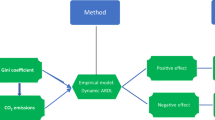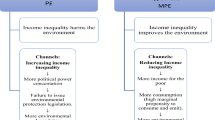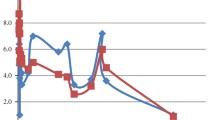Abstract
The emerging environmental concerns are entrenched in social issues, largely stem from income differences and power disparity. Income distribution and environmental disruption are increasingly pointed as obstacles in securing sustainable development goals and environmental preservation. The existing empirical studies have explored the environmental pollution impact of income inequality. However, the results are conflicting, and little attention has been paid to explore the short and long-run environmental impacts from a national viewpoint. Similarly, the role of aggregate income and financial sector for environmental quality has attracted considerable attention and many studies have provided conflicting empirical evidence. The literature generally ignores the importance of relative income in explaining environmental outcomes and also assumes symmetric association, ignoring asymmetric shocks. The present study explores the role of nonlinear associations in forming the links between income distribution and environmental quality using linear and nonlinear autoregressive distributed lag models from 1972 to 2018. The study follows the extended environmental Kuznets curve (EKC) approach. The results suggest that inequality promotes environmental pollution. Further financial development also escalates carbon emissions. The nonlinear analysis confirms the asymmetric effect of inequality on ecological footprint. The EKC, however, is not validated for Pakistan. The results suggest important policy implications.






Similar content being viewed by others
Data availability
Data sources are clearly mentioned. Interested person can access the data.
References
Ahmad, M, Ahmed, Z, Yang, X, Hussain, N, & Sinha, A (2021) Financial development and environmental degradation: do human capital and institutional quality make a difference?. Gondwana Research
Ahmad, W, & Majeed, MT (2021) Does renewable energy promote economic growth? Fresh evidence from South Asian economies. Journal of Public Affairs, e2690
Ahmad, W, Ullah, S, Ozturk, I, & Majeed, MT (2020) Does inflation instability affect environmental pollution? Fresh evidence from Asian economies. Energy & Environment, 0958305X20971804
Ahmed, Z, Cary, M, Shahbaz, M, & Vo, XV (2021b) Asymmetric nexus between economic policy uncertainty, renewable energy technology budgets, and environmental sustainability: Evidence from the United States. Journal of Cleaner Production, 127723
Ahmed Z, Zhang B, Cary M (2021a) Linking economic globalization, economic growth, financial development, and ecological footprint: evidence from symmetric and asymmetric ARDL. Ecological Indicators 121:107060
Baek J, Gweisah G (2013) Does income inequality harm the environment? Empirical evidence from the United States. Energy Policy 62:1434–1437
Bhattacharya M, Churchill SA, Paramati SR (2017) The dynamic impact of renewable energy and institutions on economic output and CO2 emissions across regions. Renewable Energy 111:157–167
Bowles S, Park Y (2005) Emulation, inequality, and work hours: was Thorsten Veblen right? The Economic Journal 115(507):F397–F412
Boyce JK (1994) Inequality as a cause of environmental degradation. Ecological Economics 11(3):169–178
Brännlund R, Ghalwash T (2008) The income–pollution relationship and the role of income distribution: an analysis of Swedish household data. Resource and Energy Economics 30(3):369–387
Chen J, Xian Q, Zhou J, Li D (2020) Impact of income inequality on CO2 emissions in G20 countries. Journal of Environmental Management 271:110987
Cheng Y, Wang Y, Chen W, Wang Q, Zhao G (2021) Does income inequality affect direct and indirect household CO 2 emissions? A quantile regression approach. Clean Technologies and Environmental Policy 23(4):1199–1213
Coondoo D, Dinda S (2008) Carbon dioxide emission and income: a temporal analysis of cross-country distributional patterns. Ecological Economics 65(2):375–385
Eriksson C, Persson J (2003) Economic growth, inequality, democratization, and the environment. Environmental and Resource Economics 25(1):1–16
Fitzgerald JB, Jorgenson AK, Clark B (2015) Energy consumption and working hours: a longitudinal study of developed and developing nations, 1990–2008. Environmental Sociology 1(3):213–223
Global Footprint Network (2020) Living planet report. Species and spaces, people and places. Available at http://data.footprintnetwork.org/#/analyzeTrends?type=EFCtot&cn=5001
Government of Pakistan (2020) Economic survey. Economic Advisor’s Wing, Ministry of Finance, Islamabad
Grunewald N, Klasen S, Martínez-Zarzoso I, Muris C (2017) The trade-off between income inequality and carbon dioxide emissions. Ecological Economics 142:249–256
Gul F, Usman M, Majeed MT (2018) Financial inclusion and economic growth: a global perspective. J Bus Econ 10(2):133–152
Guo, Y, You, W, & Lee, CC (2020) CO 2 emissions, income inequality, and country risk: some international evidence. Environmental Science and Pollution Research, 1-21
Heerink N, Mulatu A, Bulte E (2001) Income inequality and the environment: aggregation bias in environmental Kuznets curves. Ecological Economics 38(3):359–367
Hübler M (2017) The inequality-emissions nexus in the context of trade and development: a quantile regression approach. Ecological Economics 134:174–185
Hundie, SK (2021) Income inequality, economic growth and carbon dioxide emissions nexus: empirical evidence from Ethiopia. Environmental Science and Pollution Research, 1-20
IPCC (2018) Special report on global warming of 1.5 _C. Incheon, Republic of Korea: Intergovernmental Panel on Climate Change. Available at: https://www.ipcc.ch/site/assets/uploads/2018/11/pr_181008_P48_spm_en.pdf. Accessed 30 June 2021
IQAir (2020) World air quality report region & city PM2. 5 ranking. IQAir AirVisual, Goldach, Switzerland
Kazemzadeh, E, Fuinhas, JA, & Koengkan, M (2021) The impact of income inequality and economic complexity on ecological footprint: an analysis covering a long-time span. Journal of Environmental Economics and Policy, 1-21
Khan S, Majeed MT (2019) Decomposition and decoupling analysis of carbon emissions from economic growth: a case study of Pakistan. Pakistan Journal of Commerce and Social Sciences 13(4):868–891
Kihombo, S, Ahmed, Z, Chen, S, Adebayo, TS, & Kirikkaleli, D (2021a) Linking financial development, economic growth, and ecological footprint: what is the role of technological innovation?. Environmental Science and Pollution Research, 1-11
Kihombo, S, Saud, S, Ahmed, Z, & Chen, S (2021b) The effects of research and development and financial development on CO 2 emissions: evidence from selected WAME economies. Environmental Science and Pollution Research, 1-11
Knight KW, Rosa EA, Schor JB (2013) Could working less reduce pressures on the environment? A cross-national panel analysis of OECD countries, 1970–2007. Global Environmental Change 23(4):691–700
Langnel Z, Amegavi GB, Donkor P, Mensah JK (2021) Income inequality, human capital, natural resource abundance, and ecological footprint in ECOWAS member countries. Resources Policy 74:102255
Li, X, Sohail, S, Majeed, MT, & Ahmad, W (2021) Green logistics, economic growth, and environmental quality: evidence from one belt and road initiative economies. Environmental Science and Pollution Research, 1-11
Magnani E (2000) The environmental Kuznets curve, environmental protection policy and income distribution. Ecol Econ 32(3):431–443
Majeed MT (2018) Information and Communication Technology (ICT) and environmental sustainability in developed and developing countries. Pakistan Journal of Commerce and Social Sciences 12(3):758–783
Majeed MT, Mazhar M (2019) Environmental degradation and output volatility: a global perspective. Pakistan Journal of Commerce and Social Sciences 13(1):180–208
Majeed MT, Mumtaz S (2017) Happiness and environmental degradation: a global analysis. Pakistan Journal of Commerce and Social Sciences (PJCSS) 11(3):753–772
Majeed MT, Samreen I, Tauqir A, Mazhar M (2020) The asymmetric relationship between financial development and CO 2 emissions: the case of Pakistan. SN Applied Sciences 2(5):1–11
Majeed, MT, Ozturk, I, Samreen, I, Luni, T (2021b) Evaluating the asymmetric effects of nuclear energy on carbon emissions in Pakistan, Nuclear Engineering and Technology, early online, 1-26
Majeed MT, Tauqir A, Mazhar M, Samreen I (2021a) Asymmetric effects of energy consumption and economic growth on ecological footprint: new evidence from Pakistan. Environmental Science and Pollution Research:1–17
Mumtaz MZ, Smith ZA (2019) Green finance for sustainable development in Pakistan. Islamabad Policy Research Institute Journal 19(2):1–34
Ozturk I, Majeed MT, Khan S (2021) Decoupling and decomposition analysis of environmental impact from economic growth: a comparative analysis of Pakistan, India, and China. Environmental and Ecological Statistics:1–28
Perron P (1989) Testing for a unit root in a time series with a changing mean. Journal of Business & Economic Statistics 8(2):153–162
Pesaran MH, Shin Y, Smith RJ (2001) Bounds testing approaches to the analysis of level relationships. Journal of Applied Econometrics 16(3):289–326
Ravallion M, Heil M, Jalan J (2000) Carbon emissions and income inequality. Oxford Economic Papers 52(4):651–669
Sadorsky P (2010) The impact of financial development on energy consumption in emerging economies. Energy Policy 38(5):2528–2535
Schmalensee R, Stoker TM, Judson RA (1998) World carbon dioxide emissions: 1950–2050. Review of Economics and Statistics 80(1):15–27
Schor JB (1998) The overspent American. Basic Books, New York
Scruggs LA (1998) Political and economic inequality and the environment. Ecological Economics 26(3):259–275
Shin Y, Yu B, Greenwood-Nimmo M (2014) Modelling asymmetric cointegration and dynamic multipliers in a nonlinear ARDL framework. In: Festschrift in honor of Peter Schmidt (pp. 281–314). Springer, New York, NY
Tamazian A, Rao BB (2010) Do economic, financial and institutional developments matter for environmental degradation? Evidence from transitional economies. Energy Economics 32(1):137–145
Tang CF, Tan BW (2014) The linkages among energy consumption, economic growth, relative price, foreign direct investment, and financial development in Malaysia. Quality & Quantity 48(2):781–797
Torras M, Boyce JK (1998) Income, inequality, and pollution: a reassessment of the environmental Kuznets curve. Ecological Economics 25(2):147–160
Tsaurai K (2019) The impact of financial development on carbon emissions in Africa. International Journal of Energy Economics and Policy 9(3):144–153
Uddin MM, Mishra V, Smyth R (2020) Income inequality and CO2 emissions in the G7, 1870–2014: evidence from non-parametric modelling. Energy Economics 88:104780
Ullah, S, Ahmad, W, Majeed, MT, & Sohail, S (2021b) Asymmetric effects of premature deagriculturalization on economic growth and CO2 emissions: fresh evidence from Pakistan. Environmental Science and Pollution Research, 1-15
Ullah S, Ozturk I, Majeed MT, Ahmad W (2021a) Do technological innovations have symmetric or asymmetric effects on environmental quality? Evidence from Pakistan. Journal of Cleaner Production 316:128239
World Bank (2020) World development indicators. World Bank, Washington, DC. Available at http://data.worldbank.org/products/wdi
Wu R, Xie Z (2020) Identifying the impacts of income inequality on CO2 emissions: empirical evidences from OECD countries and non-OECD countries. Journal of Cleaner Production 277:123858
Yang B, Ali M, Hashmi SH, Shabir M (2020) Income inequality and CO2 emissions in developing countries: the moderating role of financial instability. Sustainability 12(17):6810
You W, Li Y, Guo P, Guo Y (2020) Income inequality and CO 2 emissions in belt and road initiative countries: the role of democracy. Environmental Science and Pollution Research 27(6):6278–6299
Yuxiang K, Chen Z (2010) Financial development and environmental performance: evidence from China. Environment and Development Economics 16(1):1–19
Zhang YJ (2011) The impact of financial development on carbon emissions: an empirical analysis in China. Energy Policy 39(4):2197–2203
Zhao, W, Zhong, R, Sohail, S, Majeed, MT, & Ullah, S (2021) Geopolitical risks, energy consumption, and CO 2 emissions in BRICS: an asymmetric analysis. Environmental Science and Pollution Research, 1-12
Zivot E, Andrews DWK (2002) Further evidence on the great crash, the oil-price shock, and the unit-root hypothesis. J Bus Econ Stat 20(1):25–44
Code availability
Computational codes are available on demand.
Author information
Authors and Affiliations
Contributions
This idea was collectively developed by Muhammad Idrees and Muhammad Tariq Majeed. Muhammad Idrees supported in all sections of this work and completed the final write up of the paper. Muhammad Tariq Majeed analyzed the data and discussed the results and drafted initial versions of the other sections. All authors have read and approved the manuscript.
Corresponding author
Ethics declarations
Ethics approval
This article does not contain any studies with human participants or animals performed by any of the authors.
Consent to participate
The author is free to contact any of the people involved in the research to seek further clarification and information.
Consent for publication
Not applicable.
Conflict of interest
The authors declare no competing interests.
Additional information
Responsible Editor: Ilhan Ozturk
Publisher’s note
Springer Nature remains neutral with regard to jurisdictional claims in published maps and institutional affiliations.
Rights and permissions
About this article
Cite this article
Idrees, M., Majeed, M.T. Income inequality, financial development, and ecological footprint: fresh evidence from an asymmetric analysis. Environ Sci Pollut Res 29, 27924–27938 (2022). https://doi.org/10.1007/s11356-021-18288-3
Received:
Accepted:
Published:
Issue Date:
DOI: https://doi.org/10.1007/s11356-021-18288-3




